ETHIOPIAN PAINTING – A LESSON IN ICONOGRAPHY!!
icon [gr] = image graphein [gr] = write or describe ⇒ iconography = description of images
the purpose of iconography is not just to describe what you see in the image, but to disclose what the relation between persons and objects may be. in ethiopian art eyes play an important role, eyes are powerful, they can harm you. the good guys and the bad ones are easy to discern by the position of the heads. frontal or in 3/4 means good, in profile is bad. by depicting someone in profile, ‘one-eyed’, he is less powerful. moreover the bad guys are often ugly in their whole appearance.
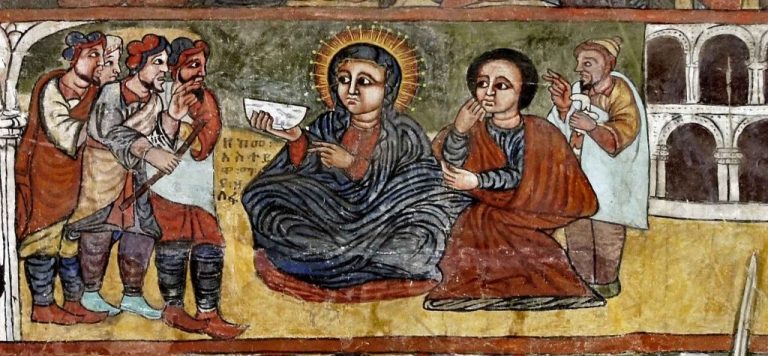
so here we see four ugly men on the left and one on the right and a nice couple in between, of which the lady holds a cup in her right hand. as this painting is situated in a church it is obvious that we have to do with a biblical story. in this case we find it in numeri 5:25. a treachurous jew has told the elders of the synagogue, that the old man joseph has impregnated his housemaid mary. she is condemned to drink the bitter waters that will make her belly swell and destroy her womb. but after drinking mary’s face starts shining and even her apparel becomes luminous. shamefaced the jews beat a hasty retreat.
………………………………………………………………………………………………………………………………………………………….

this axonometric view of the narga selassi church shows what round churches, built after the 16th century, may look like. two round walls, in wood, reed, or stone enclose a cube of about 6 meters with a tambour on top. its inner part is called the makdas in which the tabot is hidden. this tabot is a kind of altar stone, but made of wood and representing the arc of the covenant.
the outer walls of the makdas are completely covered by biblical [sometimes historical] images. the images may be painted directly on the wall [murals] or painted on cloth and then glued to the wall. some writers call these paintings frescoes, but painting in fresco means painting on wet stucco and that is out of the question in ethiopia.
………………………………………………………………………………………………………………………………………………………….
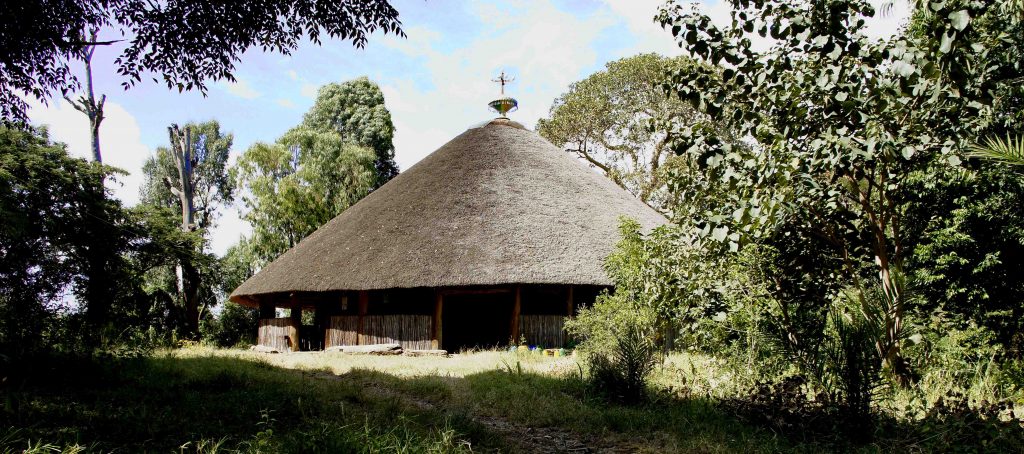
DEBRE SINA MARYAM
on the northern shore of lake tana, in the village of gorgora, is situated this fascinating church of the sinaï monastery dedicated to saint mary. the building as well as the paintings date from the 17th century.
the outer wall is made of reed. the monumental thatched roof, corbeling out all around, has not [yet] been replaced by a more sought after one executed in corrugated iron.
………………………………………………………………………………………………………………………………………………………….
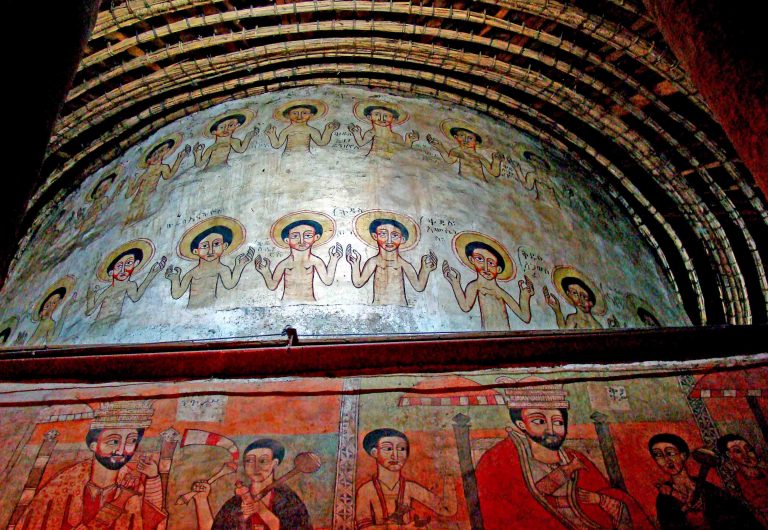 a detail of the makdas inside the church. the tambour on top of the cube supports the thatched conical roof. every inch of the makdas is covered with mural paintings, a habit that is called horror vacui, fear of emptyness. the naked figures on the tambour represent forty martyrs who were drowned in lake tana during the regime of grañ. below two old testament kings.
a detail of the makdas inside the church. the tambour on top of the cube supports the thatched conical roof. every inch of the makdas is covered with mural paintings, a habit that is called horror vacui, fear of emptyness. the naked figures on the tambour represent forty martyrs who were drowned in lake tana during the regime of grañ. below two old testament kings.
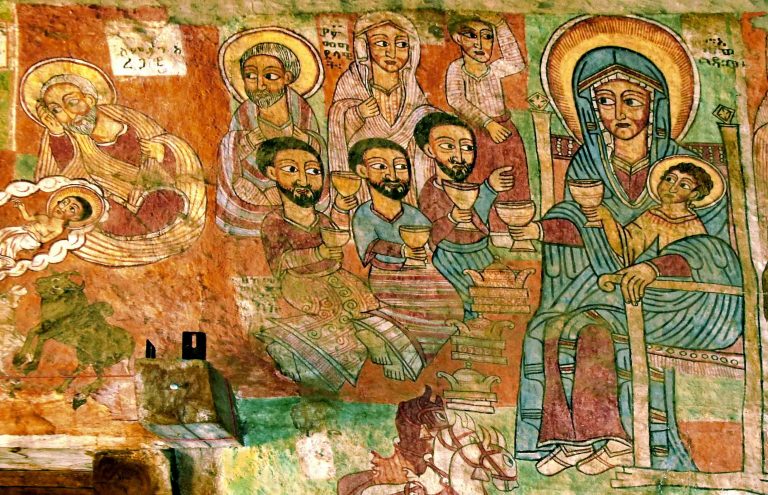
the new testament starts with the birth of the son of mary, jesus. mary and child are seated on the right and three wise kings are kneeling before them, their crowns on the floor at their knees. saint joseph has taken place behind the kings. so far the story is familiar to us, be it that we associate the kings more with camels to travel on than on the three little ponies at the bottom of the painting. the painting technique is not complicated. a drawing in black lines is filled in with paint. the dark spots on the faces represent shadows. parallel lines in the apparel are used for modelling the bodies and suggesting folds.
there are also some intreaging details to be noticed. the kings, mary and jesus are raising their cups to drink to the health of the new born baby-king. judging from the cup in jesus’ hand he is fully participating in the toast by drinking the same ’tedj’ as the guest do. this honey wine is a rather strong alcoholic drink. quite stunning for a baby of that age. or is it the painter’s sense of humour?
there is more to say about the cups if we look at those in the hands of the kings. the first and the second king both raise two cups. the third king shows an empty hand and his right arm is missing, so he has no drink at all. which arm belongs to whome can be determined by the colour of their sleeves. and look at their hands! there are five right hands only, independant of the right or left arm. and then a closer look at mary and jesus reveales two left hands on two right arms. instead of humor I think we have to do with an inadequately worked-out drawing here. and yet there is a humourous detail in this painting…
ethiopian painters often depict different scenes within the same pictorial environment without any separating element. here all eyes are turned towards mother and child. only the haloed man in the top row looks into te oppposite direction to another haloed man in a different scene. both of them are saint joseph. the one on the right is looking at himself on the left in the birth scene where jesus rests his head on joseph’s knee. this is intended to be humorous and makes us smile indeed.
………………………………………………………………………………………………………………………………………………………….
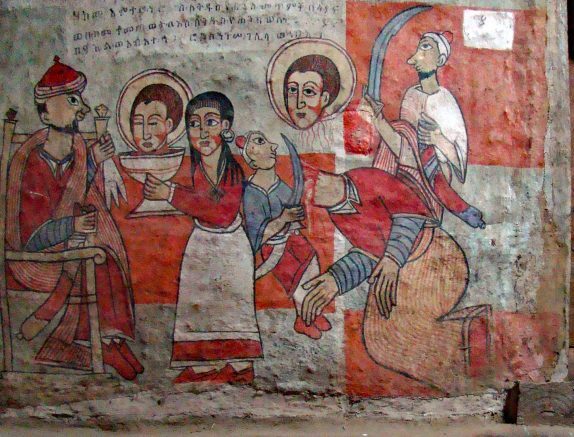
here we have another example of different scenes within the same framing. it is about the decapitation of saint john the baptist by a king called herod. the king had married his brother’s wife herodias. she hated john because he had lectured herod about this indecent marriage. though herod had put him in jail he considered him a too interesting interlocutor to change his imprisonment into martyrdom. until…
on the occasion of the king’s birthday, his daughter salome had just completed a dance manipulating her veil in such a way that her father became very excited over it. she may wish whatever she likes and it shall be fulfilled. salome consults her
mother, who sees her opportunity. the head of john the baptist would make a gorgeous present. a promise is a promise is also the king’s adage.
on the right the executioner disconnects john’s head from his body. instead of falling down the head flies up crying out to herod and herodias one last time, defiantly and naggingly: “and yet it is indecent that you take your brother’s wife”. so within the same painting three scenes are put together: the beheading, the flying head and salome receiving john’s head in a huge chalice from her father. notice how the good differ from the the bad and ugly by the positions of their heads.
NARGA SELASSI
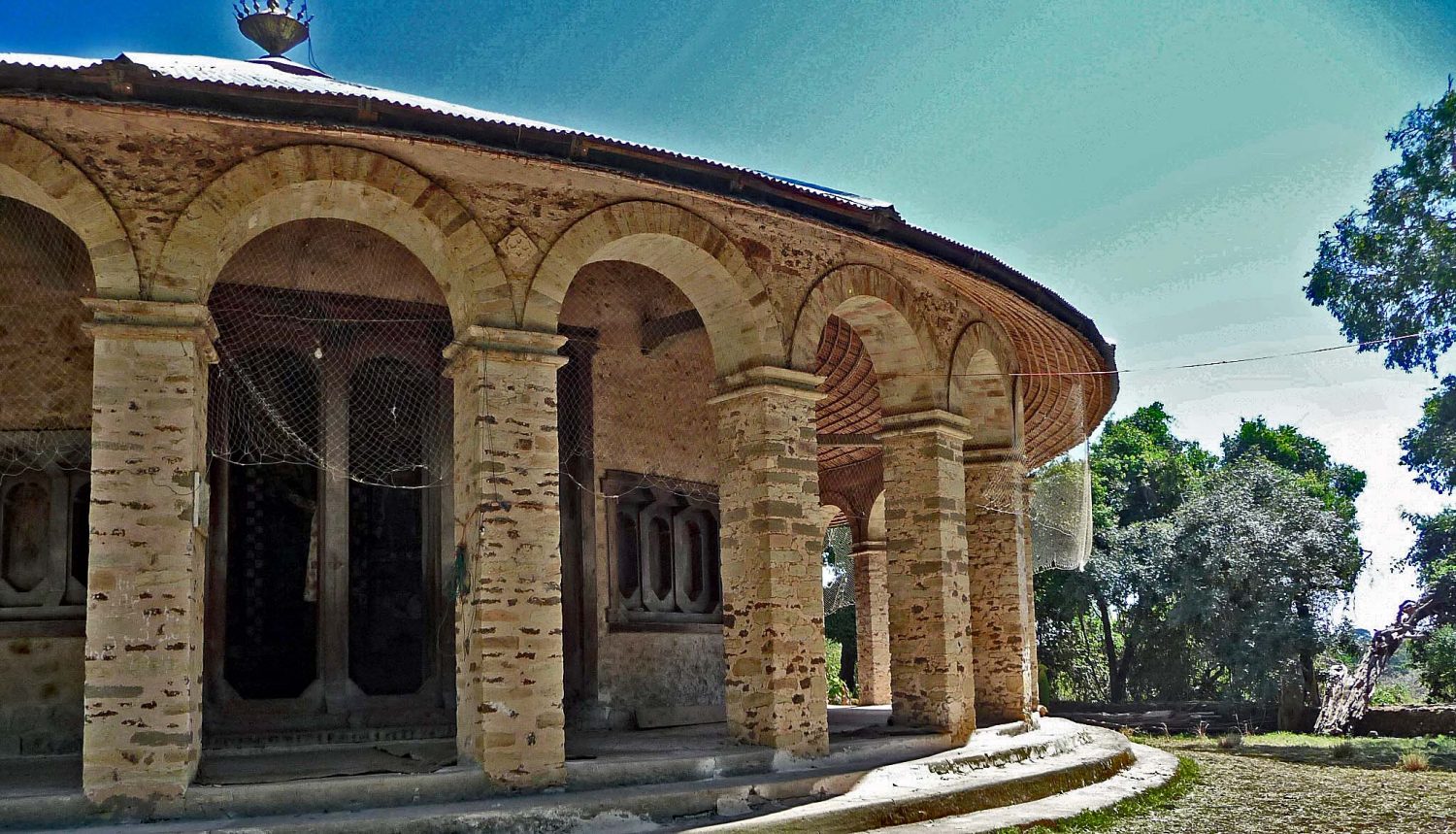
the narga selassi church is situated on the island of narga in lake tana. it differs in many ways from the previous debre sina maryam church. the roof is covered with corrugated iron, wich is considered more durable and luxury than a thatched roof. the roof is supported by the beautiful arcade of the outer wall as well as by the inner wall that contains gorgeous wooden doors and windows.
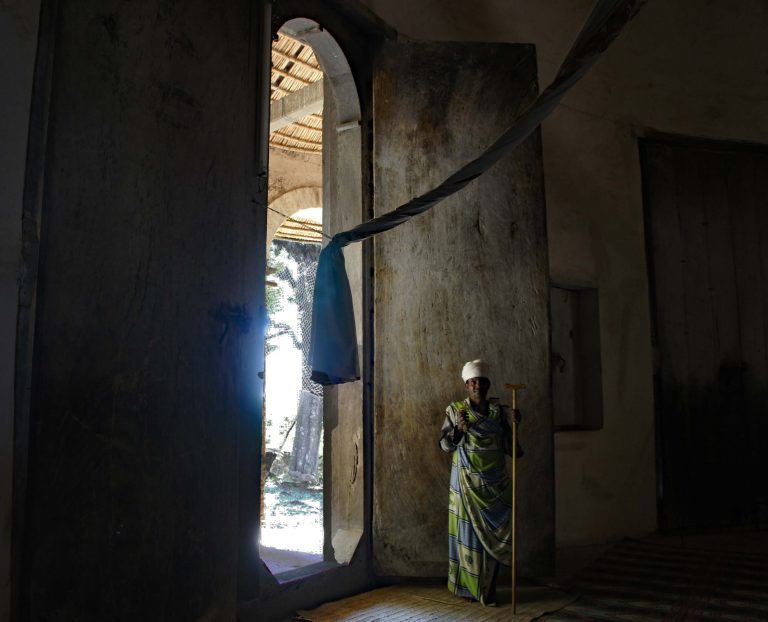
the stunning feature about this door is that it is a monoxyl, i.e. one piece of wood. imagine the age and size of the tree that was needed to cut this door out of the stem… by hand!
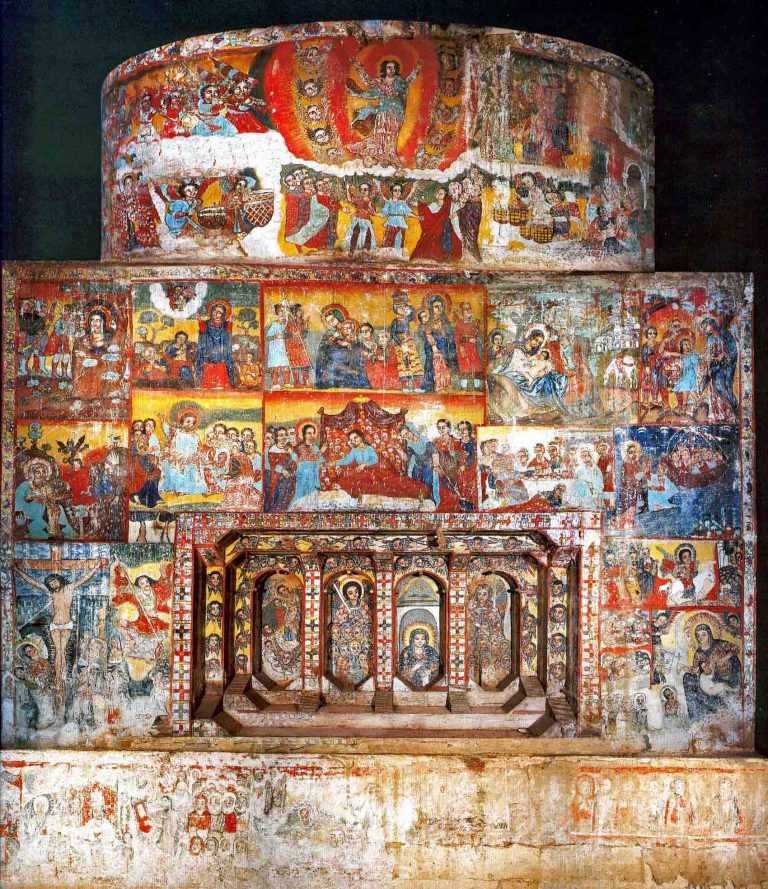
the entire eastwall of the makdas with its window frame and four shutters. on the other three sides there is a door. not on this side, because behind this wall the most sacred object of the church is located, the tabot, representing the arc of the covenant. [the picture dates from before the restoration of the entire iconographical program].
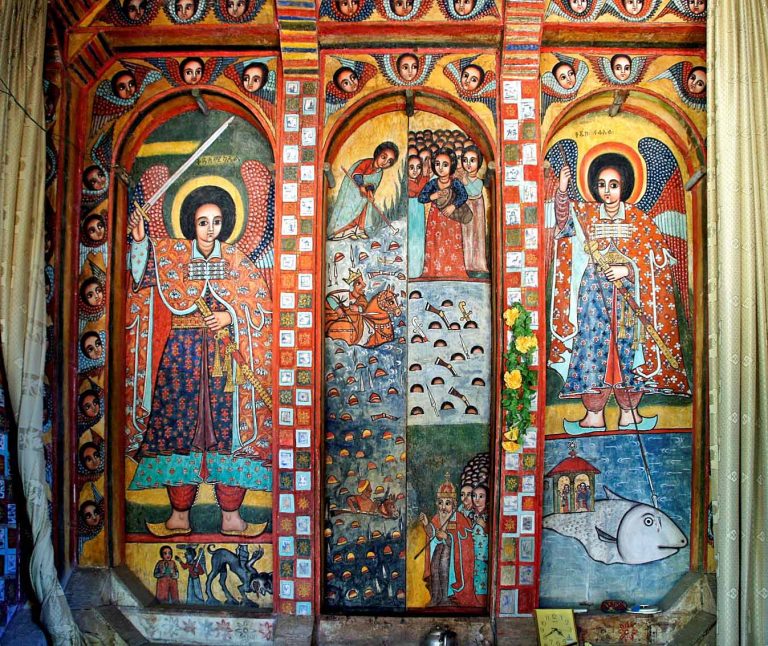
on the westside a triforate entrance for the clergy only. to the left and the right two archangels, gatekeepers of this holy of holies. in this case both of them take also part in two different narrations. the central door tells us a third story, the passage through the red sea. moses had struck the water to
enable his sister miryam to cross with the women.
now he strikes the water again to close the passage. in the middle the egypt pharao and his soldiers are drowning in the red sea waters and at the bottom moses’ brother aäron is leading the men after the passage.

these two colourful figures painted on the outer wall of a church in the gojam region, the muga debre iyasus, show even more clearly how painters to-day work. the colours are vivid and in harmony. their apparel is richly decorated but this floral decoration does not follow the folds. it is painted flat on the fabric. the background of the figure to the right is rather traditional, just a green, yellow and red field. the figure to the left seems to be an angel with six pairs of multicoloured wings that fill in the whole background together with two threatening but elegant serpents encircling this marvellous composition.
yet it will be difficult to judge the age of a painting after the stylistic characteristics. there is no evident chronological evolution in the painting tradition. if the clergy wants a church to be painted in the style of a 16th century church, they will look for a painter who can do so.